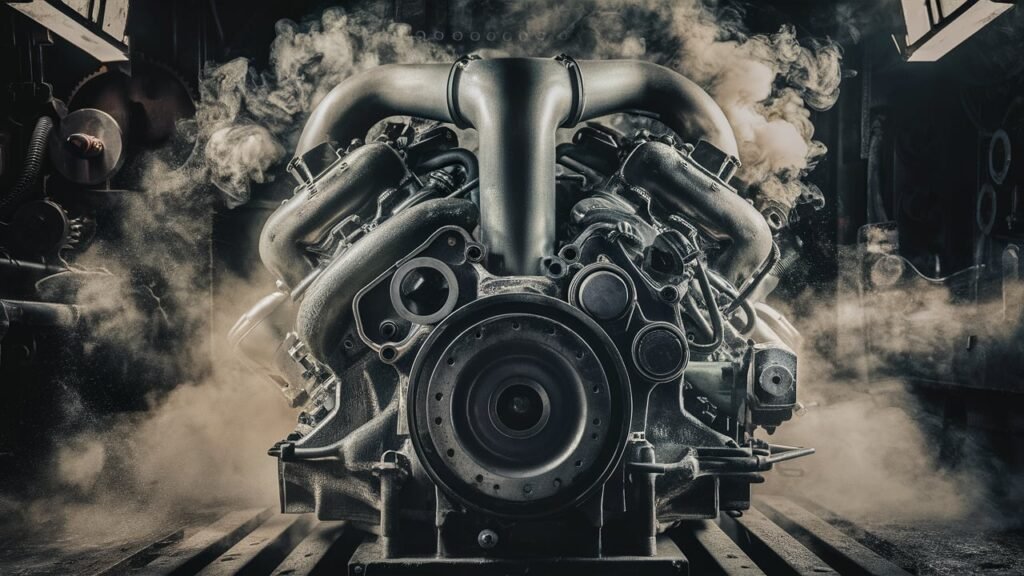
Signs Your Car Engine Timing Belt Needs Attention | Essential Maintenance Tips
In the intricate symphony of components that compose an automobile’s internal combustion engine, the car engine timing belt plays a silent yet crucial role. Relying on precise synchronization, this specially designed cogged belt ensures that the camshaft and crankshaft rotate in perfect harmony, orchestrating the opening and closing of valves at precisely timed intervals.
Without this unassuming belt, an engine’s operation would quickly devolve into chaos, with components colliding and power delivery becoming erratic. Understanding the intricacies of the timing belt proves fundamental for every car owner and enthusiast seeking to maintain their vehicle’s optimal performance.
The significance of the timing belt lies not only in its mechanical function but also in its role as the linchpin holding together an engine’s various systems. A well-maintained timing belt safeguards against catastrophic engine failures, prevents valve interference, and sustains peak performance levels.
However, neglecting this critical component can lead to a domino effect of issues ranging from misfires and overheating to abrupt loss of power—a scenario no driver wishes to encounter unexpectedly.
Therefore, recognizing the signs indicating when your car engine timing belt requires attention becomes paramount for ensuring your vehicle’s longevity and reliability on the road. Let us delve into eight unmistakable indicators that signal it may be time to give your timing belt some well-deserved scrutiny.
Unusual Sounds and Noises.
If you start noticing grinding or ticking sounds emanating from the engine area of your vehicle, it could be a tell-tale sign of underlying timing belt issues. These noises are often indicators of the belt rubbing against components it shouldn’t, potentially due to misalignment caused by wear or damage.
It’s crucial not to dismiss these sounds as they can escalate into more severe problems if left unaddressed. For instance, imagine you hear a high-pitched whining noise while driving; this could signal a worn-out timing belt that is struggling to function correctly.
Ignoring this warning could lead to costly repairs down the line, highlighting the importance of promptly investigating any unusual engine noises.

To better understand why grinding or ticking sounds indicate timing belt concerns, picture a well-oiled machine suddenly producing irregular clanking noises – an obvious signal that something within its intricate system is malfunctioning.
Similarly, when your car engine emits such unsettling sounds, it’s akin to a distress call from the timing belt mechanism asking for attention. Additionally, consider the discomfort of driving in your vehicle while being serenaded by persistent whining noises.
This can serve as a clear prompt for drivers to act swiftly in diagnosing and resolving potential timing belt issues before they become more severe.
Visible Wear and Tear.
When conducting a visual inspection of your car’s timing belt, be on the lookout for any signs of wear and tear that could signal imminent issues. Cracks, fraying, or visible damage on the timing belt are clear indicators that it’s time for attention.
These physical manifestations are often the first visual cues that your timing belt is reaching the end of its lifespan. Ignoring these warning signs can lead to catastrophic engine failure or costly repairs down the line.
Moreover, the presence of oil or coolant leaks near the timing belt can significantly accelerate wear and deterioration. Oil and coolant can seep onto the belt, causing it to deteriorate faster and lose its integrity.
This contamination not only weakens the belt itself but also affects other components in the engine system. If you spot any leaks in proximity to your timing belt during routine checks or maintenance, it’s crucial to address them promptly to prevent further damage and potential failure.
To illustrate, imagine noticing fraying at the edges of your timing belt during a routine inspection. This fraying indicates that the internal fibers of the belt are weakening, jeopardizing its ability to synchronize the engine components efficiently.
Similarly, imagine finding oil seepage near your timing belt while working under your vehicle. This leakage could compromise the material strength of the belt over time due to exposure to corrosive substances. By paying attention to these visible indications of wear and addressing them proactively, you can avoid costly repairs and ensure your engine operates smoothly and reliably.
Engine Misfires and Rough Idling.
A telltale sign that your car’s engine timing belt needs attention is the occurrence of engine misfires and rough idling. When a timing belt starts slipping, it can disrupt the synchronization between the camshaft and crankshaft, leading to misfires in the engine cylinders.
These misfires can cause noticeable vibrations or a shaky sensation while idling. Imagine sitting in your parked car and feeling subtle tremors running through the steering wheel and dashboard – this could be an indication of timing belt issues affecting the engine’s performance.

Moreover, if you experience sudden stalling or a loss of power while driving, it could be attributed to problems with the timing belt. Picture driving along a highway when suddenly your car loses acceleration power or comes to an unexpected stop – this abrupt interruption in smooth operation may stem from a failing timing belt causing crucial components of the engine to fall out of sync. Such occurrences not only compromise your vehicle’s drivability but also pose safety risks on the road.
In essence, keeping a keen eye (and ear) out for these symptoms of engine misfires and rough idling can help you catch potential timing belt problems early on. Addressing these issues promptly can prevent more severe consequences like complete engine failure or costly repairs down the line.
Remember, being vigilant about these signs can save you time, money, and ensure your vehicle stays in optimal working condition for longer durations.
Engine Overheating.
An engine that runs hotter than usual can often be traced back to a malfunctioning timing belt. The timing belt plays a crucial role not only in coordinating the engine’s internal components but also in ensuring the proper operation of the cooling system.
If the timing belt slips or wears out, it can throw off the synchronization of engine parts, impacting overall performance and potentially leading to overheating issues. For example, imagine a scenario where an older timing belt loses its grip on the camshaft or crankshaft gears – this misalignment can disrupt the engine’s cycle, causing it to generate excess heat due to inefficient combustion processes.
One clear indication of a failing timing belt causing engine overheating is observing an uptick in coolant temperature even when there are no visible leaks or other apparent issues with the cooling system. Picture driving your car on a sunny day, and despite regular coolant levels and no leaks under the hood, you notice that the temperature gauge starts creeping higher than normal.
This anomaly could signal trouble brewing within the timing belt mechanism, affecting not just engine performance but also jeopardizing critical cooling functions essential for preventing overheating-related damage.
Ignoring persistent engine overheating caused by a faulty timing belt can lead to severe consequences such as warped cylinder heads or even complete engine failure. Picture experiencing multiple episodes of overheating due to a deteriorating timing belt that finally snaps while driving on a busy highway – this sudden breakdown could result in significant repair costs or potential safety hazards.
Therefore, promptly addressing any signs of increased engine temperatures linked to timing belt issues is paramount in maintaining both your vehicle’s performance and your safety behind the wheel.
Poor Fuel Efficiency.
Poor fuel efficiency can often be linked to issues with the car’s timing belt. When the timing belt becomes compromised, it can result in inconsistent engine performance, causing the vehicle to consume more fuel than usual.
This inefficiency is due to the engine not operating at its optimal levels, leading to increased fuel consumption for the same amount of work. Drivers might notice a decrease in miles per gallon and find themselves refilling their tanks more frequently, indicating a potential problem with the timing system.
One common symptom of a faulty timing belt affecting fuel efficiency is experiencing dragging or resistance during acceleration. As the timing belt plays a crucial role in synchronizing the movement of the engine’s internal components, any disruption in this synchronization can lead to hesitations or delays in power delivery.

This resistance feeling could manifest as sluggish acceleration or uneven power output, resulting in a noticeable impact on fuel consumption over time.
To illustrate this point further, imagine driving up a hill and feeling that your vehicle is struggling to maintain speed despite pressing down on the accelerator pedal. This sensation of dragging or lack of response can be indicative of timing belt issues affecting engine performance and ultimately causing poor fuel efficiency.
Addressing these symptoms promptly through inspection and potential replacement of the timing belt can help restore optimal engine function and improve fuel economy.
Check Engine Light Activation.
When your car’s check engine light flickers to life on the dashboard, it serves as a mysterious harbinger of potential issues under the hood. Among the myriad malfunctions it can signal, problems with the timing belt are not uncommon.
However, decoding this warning light requires more than just speculation. Professional mechanics utilize diagnostic tools that communicate with your vehicle’s onboard computer to pinpoint the exact source of trouble. These advanced tools can assess the condition of various components, including the timing belt, providing a precise diagnosis and guiding the necessary repairs.
For instance, imagine driving down a busy highway when suddenly, your check engine light glows ominously. While you might feel immediate anxiety about what could be wrong, rest assured that this alert system is designed to help unravel automotive mysteries efficiently.
By engaging a trusted mechanic equipped with diagnostic tools, you can swiftly get to the root of the issue. In many cases, addressing timing belt concerns early based on these diagnostics can save you from costly repairs or unexpected breakdowns in the future.
Regularly checking in with your car’s diagnostic systems can enhance your understanding of its overall health and ensure timely interventions for potential problems like timing belt issues. Through strategic use of technology and expertise from professionals, you can navigate any complexities hidden within your vehicle’s mechanical systems with confidence.
Remember, while the check engine light may trigger initial worry, leveraging modern diagnostic capabilities will ultimately empower you to make informed decisions regarding maintenance and upkeep for your car’s longevity and performance.
Mileage and Maintenance History.
Car engine timing belts are crucial components that require periodic replacement to ensure optimal engine performance and prevent costly repairs. Manufacturers specify recommended intervals for timing belt replacements based on mileage, typically ranging from 60,000 to 100,000 miles.
Consulting your vehicle’s manual or contacting the manufacturer directly can provide you with the exact mileage at which your timing belt should be replaced. Adhering to these guidelines is essential for safeguarding your engine against potential failure due to a worn-out timing belt.
Maintaining detailed maintenance records is key to tracking the condition of critical components like the timing belt in your vehicle. By documenting inspection dates and replacement schedules for various parts, including the timing belt, you establish a proactive approach to upkeep.
For instance, noting down when the timing belt was last checked or changed allows you to anticipate future maintenance needs accurately. This organized record-keeping ensures that vital components are serviced promptly, reducing the risk of unexpected breakdowns.

For example, if your car has reached the designated mileage for a timing belt replacement but lacks documented maintenance history indicating it has been changed before, it is advisable to prioritize this service.
Neglecting timely replacement based on both manufacturer recommendations and actual mileage can lead to severe engine damage if the aging timing belt fails unexpectedly. Regularly updating and referencing your maintenance records enables you to stay ahead of potential issues by identifying when critical components need servicing or replacement.
Signs of Impending Failure.
As a car owner, being aware of the signs that indicate an impending timing belt failure can save you from costly engine damage. One significant warning signal is reduced power output. If you notice that your vehicle struggles during acceleration or requires more effort to maintain speed, it could be a sign of timing belt wear.
As the timing belt deteriorates, it may not synchronize the engine components properly, leading to decreased performance and efficiency.
Moreover, sudden loss of acceleration is another critical symptom that shouldn’t be overlooked. Imagine driving on the highway when your car unexpectedly loses power and fails to respond to the gas pedal promptly; this scenario might be due to a failing timing belt.
In such instances, immediate action is crucial to prevent further damage and potentially hazardous situations on the road. Recognizing these nuances in your vehicle’s behavior allows you to address timing belt issues proactively before they escalate into severe malfunctions.
By educating yourself about these subtle hints of imminent timing belt failure, you empower yourself to take preventative maintenance measures for your vehicle.
Regular inspections by qualified mechanics or DIY enthusiasts who possess adequate automotive knowledge can help detect early signs of timing belt wear and ensure timely replacements. Remember, staying attentive to your car’s performance cues can make a significant difference in preserving your engine’s longevity and overall functionality.
Conclusion: Proactive Timing Belt Maintenance.
In conclusion, being attentive to the signs indicating timing belt issues in your car is crucial for proactive maintenance. Addressing warning signals promptly can prevent more significant problems and costly repairs down the line.
By staying alert to unusual sounds, visible wear and tear, engine misfires, overheating, poor fuel efficiency, check engine light activations, mileage considerations, and impending failure indicators, car owners can maintain their vehicles’ optimal performance.
Regularly monitoring your car’s timing belt health and adhering to manufacturer-recommended maintenance schedules will help ensure the longevity of your engine. Remember that the timing belt plays a critical role in synchronizing internal engine components.
Ignoring warning signs may lead to severe damage or complete engine failure. Stay informed, stay proactive, and prioritize timely inspections and replacements to keep your vehicle running smoothly and safely. Your diligence in addressing these warning signs now can save you from major inconveniences later on.




